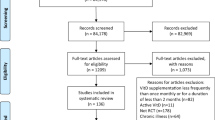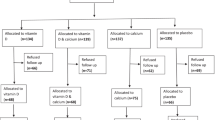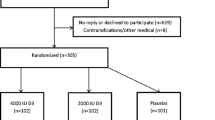Abstract
Summary
In the Middle East and North Africa (MENA), a vitamin D dose ≥2000 IU/day may be needed to allow to the majority of the population to reach the target 25-hydroxyvitamin D (25(OH)D) level ≥20 ng/ml. Data in the region on the effect of vitamin D supplementation on various skeletal and extra-skeletal effects are scarce.
Introduction
Hypovitaminosis D is prevalent worldwide, more so in the Middle East and North Africa (MENA). This study aims to determine the effects of vitamin D replacement on the mean difference in 25-hydroxyvitamin D [25(OH)D] level reached and other outcomes, in the MENA.
Methods
This is a meta-analysis of randomized trials from the MENA, administering vitamin D supplementation for at least 3 months, without language or time restriction. We conducted a comprehensive search in seven databases until July 2015. We abstracted data from published reports, independently and in duplicate. We calculated the mean difference (MD) and 95 % CI of 25(OH)D level reached for eligible comparisons, and pooled data using RevMan version 5.3.
Results
We identified 2 studies in elderly and 17 in adults; for the latter, 11 were included in the meta-analysis. Comparing a high vitamin D dose (>2000 IU/day) to placebo (nine studies), the MD in 25(OH)D level achieved was 18.3 (CI 14.1; 22.5) ng/ml; p value < 0.001; I 2 = 92 %. Comparing an intermediate dose (800–2000 IU/day) to placebo (two studies), the MD in 25(OH)D level achieved was 14.7 (CI 4.6; 24.9) ng/ml; p value 0.004; I 2 = 91 %. Accordingly, 89 and 71 % of participants, in the high and intermediate dose groups, respectively, reached the desirable level of 20 ng/ml. The risk of bias in the included studies was unclear to high, except for three studies.
Conclusion
In the MENA region, vitamin D doses ≥2000 IU/day may be needed to reach the target 25(OH)D level ≥20 ng/ml. The long-term safety and the efficacy of such doses on various outcomes are unknown.



Similar content being viewed by others
References
Hilger J, Friedel A, Herr R et al (2014) A systematic review of vitamin D status in populations worldwide. Br J Nutr 111(01):23–45
Mithal A, Wahl D, Bonjour J-P et al (2009) Global vitamin D status and determinants of hypovitaminosis D. Osteoporos Int 20(11):1807–1820
Arabi A, El Rassi R, El Hajj Fuleihan G (2010) Hypovitaminosis D in developing countries—prevalence, risk factors and outcomes. Nat Rev Endocrinol 6(10):550–561
Bassil D, Rahme M, Hoteit M, El Hajj Fuleihan G (2013) Hypovitaminosis D in the Middle East and North Africa. Dermatoendocrinol 5(2):274–298
Gannagé-Yared MH, Maalouf G, Khalife S et al (2009) Prevalence and predictors of vitamin D inadequacy amongst Lebanese osteoporotic women. Br J Nutr 101(4):487–491
Barry EL, Rees JR, Peacock JL et al (2014) Genetic variants in CYP2R1, CYP24A1, and VDR modify the efficacy of vitamin D3 supplementation for increasing serum 25-hydroxyvitamin D levels in a randomized controlled trial. J Clin Endocrinol Metab 99(10):E2133–E21E7
Arabi A, Khoueiry-Zgheib N, Mahfouz R (2016) CYP2R1 gene polymorphisms are associated with variability in 25-hydroxyvitamin D levels in the elderly. Osteoporos Int In Press
Dawson-Hughes B, Mithal A, Bonjour J-P et al (2010) IOF position statement: vitamin D recommendations for older adults. Osteoporos Int 21(7):1151–1154
Ross C TC, Yaktine A, Del Valle H, IOM (Institute of Medicine) (2011) Dietary reference intakes for calcium and vitamin D. The National Academies Press, Washington, DC, p 662
Holick MF, Binkley NC, Bischoff-Ferrari HA et al (2011) Evaluation, treatment, and prevention of vitamin D deficiency: an Endocrine Society clinical practice guideline. J Clin Endocrinol Metab 96(7):1911–1930
Green S (2011) Cochrane handbook for systematic reviews of interventions version 5.1.0 [updated March 2011]. The Cochrane Collaboration.
Effects of different doses of vitamin D replacement in Middle Eastern and North African population: A systematic review and meta-analysis protocol. 2014. Available from: http://www.crd.york.ac.uk/PROSPERO/display_record.asp?ID=CRD42014010488 (accessed in April 2016)
World Band definition of Middle East and North Africa countries. Available from: http://data.worldbank.org/about/country-and-lending-groups (accessed in April 2016).
Confidence Interval Online Calculation. Available from: https://www.mccallum-layton.co.uk/tools/statistic-calculators/confidence-interval-for-proportions-calculator/. (accessed in April 2016).
Baker W, Michael White C, Cappelleri J, Kluger J, Coleman C (2009) Understanding heterogeneity in meta-analysis: the role of meta-regression. Int J Clin Pract 63(10):1426–1434
Sharifi N, Amani R, Hajiani E, Cheraghian B (2014) Does vitamin D improve liver enzymes, oxidative stress, and inflammatory biomarkers in adults with non-alcoholic fatty liver disease? A randomized clinical trial. Endocrine 47(1):70–80
Sadiya A, Ahmed SM, Carlsson M et al (2015) Vitamin D 3 supplementation and body composition in persons with obesity and type 2 diabetes in the UAE: a randomized controlled double-blinded clinical trial. Eur J Clin Nutr 69(6):707–711
El Hajj Fuleihan G, Baddoura R, Habib RH et al. (2016) A randomized trial investigating the impact of vitamin D replacement on indices of insulin resistance in elderly overweight subjects. Am J Clin Nutr pii: ajcn132589. [Epub ahead of print]
Al-Sofiani ME, Jammah A, Racz M et al (2015) Effect of vitamin D supplementation on glucose control and inflammatory response in type II diabetes: a double blind, randomized clinical trial. Int J Endocrinol Metab 13(1):e22604
Breslavsky A, Frand J, Matas Z, Boaz M, Barnea Z, Shargorodsky M (2013) Effect of high doses of vitamin D on arterial properties, adiponectin, leptin and glucose homeostasis in type 2 diabetic patients. Clin Nutr 32(6):970–975
Golan D, Staun-Ram E, Glass-Marmor L et al (2013) The influence of vitamin D supplementation on melatonin status in patients with multiple sclerosis. Brain Behav Immun 32:180–185
Ghavamzadeh S, Mobasseri M, Mahdavi R (2014) The effect of vitamin D supplementation on adiposity, blood glycated hemoglobin, serum leptin and tumor necrosis factor-α in type 2 diabetic patients. Int J Prev Med 5(9):1091
Moghassemi S, Marjani A (2014) The effect of short-term vitamin D supplementation on lipid profile and blood pressure in post-menopausal women: a randomized controlled trial. Iran J Nurs Midwifery Res;19(5):517.
Rashidi B, Haghollahi F, Shariat M, Zayerii F (2009) The effects of calcium-vitamin D and metformin on polycystic ovary syndrome: a pilot study. Taiwan J Obstet Gynecol 48(2):142–147
Gendelman O, Itzhaki D, Makarov S, Bennun M, Amital H (2015) A randomized double-blind placebo-controlled study adding high dose vitamin D to analgesic regimens in patients with musculoskeletal pain. Lupus 24(4–5):483–489
Begay R, Afkham Zadah AR, Danshiyour N (2012) The effect of calcium—vitamin D on the success of ovulation induction in infertile women with polycystic ovary syndrome. IJOGI 15(14):7–13
Taheri M, Baheiraei A, Foroushani AR, Modarres M (2014) Resolving vitamin D deficiency in the preconception period among high-risk reproductive women: a randomized controlled trial. Iran Red Crescent Med J 16(1):e11175
Al-Zahrani MK, Elnasieh AM, Alenezi FM et al (2014) A 3-month oral vitamin D supplementation marginally improves diastolic blood pressure in Saudi patients with type 2 diabetes mellitus. Int J Clin Exp Med 7(12):5421
Nasri H, Behradmanesh S, Maghsoudi AR, Ahmadi A, Nasri P, Rafieian-Kopaei M (2014) Efficacy of supplementary vitamin D on improvement of glycemic parameters in patients with type 2 diabetes mellitus; a randomized double blind clinical trial. J Renal Inj Prev 3(1):31
Ahmadi N, Mortazavi M, Iraj B, Askari G (2013) Whether vitamin D3 is effective in reducing proteinuria in type 2 diabetic patients? J Res Med Sci 18(5):374
Firouzabadi R, Aflatoonian A, Modarresi S, Sekhavat L, Taheri S (2012) Therapeutic effects of calcium & vitamin D supplementation in women with PCOS. Complement Ther Clin Pract 18(2):85–88
Tehrani HG, Mostajeran F, Shahsavari S (2014) The effect of calcium and vitamin D supplementation on menstrual cycle, body mass index and hyperandrogenism state of women with polycystic ovarian syndrome. J Res Med Sci 19(9):875
Salehpour A, Hosseinpanah F, Shidfar F et al (2012) A 12-week double-blind randomized clinical trial of vitamin D3 supplementation on body fat mass in healthy overweight and obese women. Nutr J 11(1):78
Hoseini SA, Aminorroaya A, Iraj B, Amini M. The effects of oral vitamin D on insulin resistance in pre-diabetic patients (2013) J Res Med Sci 18(1):47.
Borenstein M, Hedges LV, Higgins J, Rothstein HR (2010) A basic introduction to fixed-effect and random-effects models for meta-analysis. Res Synth Methods 1(2):97–111
Gallagher JC, Sai A, Templin T, Smith L (2012) Dose response to vitamin D supplementation in postmenopausal women: a randomized trial. Ann Intern Med 156(6):425–437
Shab-Bidar S, Bours S, Geusens PP, Kessels AG, van den Bergh JP (2014) Serum 25 (OH) D response to vitamin D3 supplementation: a meta-regression analysis. Nutrition 30(9):975–985
Cashman KD, Fitzgerald AP, Kiely M, Seamans KM (2011) A systematic review and meta-regression analysis of the vitamin D intake–serum 25-hydroxyvitamin D relationship to inform European recommendations. Br J Nutr 106(11):1638–1648
Dawodu A, Saadi HF, Bekdache G, Javed Y, Altaye M, Hollis BW (2013) Randomized controlled trial (RCT) of vitamin D supplementation in pregnancy in a population with endemic vitamin D deficiency. J Clin Endocrinol Metab 98(6):2337–2346
Sebaaly A, Bachour F, Bayoud W et al (2015) The extra-skeletal actions of vitamin. D - Myths and facts. J Med Liban 63(2):87–93
Wacker M, Holick MF (2013) Vitamin D—effects on skeletal and extraskeletal health and the need for supplementation. Nutrients 5(1):111–148
Maalouf NM (2008) The noncalciotropic actions of vitamin D: recent clinical developments. Curr Opin Nephrol Hypertens 17(4):408–415
Seamans KM, Cashman KD (2009) Existing and potentially novel functional markers of vitamin D status: a systematic review. Am J Clin Nutr 89(6):1997S–2008S
Guyatt GH, Oxman AD, Kunz R et al (2011) GRADE guidelines: 7. Rating the quality of evidence—inconsistency. J Clin Epidemiol 64(12):1294–1302
El-Hajj Fuleihan G, Bouillon R, Clarke B et al (2015) Serum 25-hydroxyvitamin D levels: variability, knowledge gaps, and the concept of a desirable range. J Bone Miner Res 30(7):1119–1133
Acknowledgements
The authors would like to thank Miss Aida Farha, Medical Information Specialist, Saab Medical Library at the American University of Beirut - Lebanon, for her advice and assistance in designing comprehensive and complex searches of the various medical literature resources and for the provision of select articles. The authors would like also to thank experts in the field involved in the development of international vitamin D guidelines, Professors Paul Lips, Michael Holick, and Roger Bouillon, for input on trials that could be relevant to our review and that may not have been caught by our search. The authors would like also to thank the corresponding authors of RCTs, Drs Mohammed Al-Sofiani and Mahshid Taheri, for sharing with us additional information on their trials. The authors would like to thank Miss Lara Kahale for providing the risk of bias assessment on the trial by El Hajj Fuleihan et al.
Author information
Authors and Affiliations
Corresponding author
Ethics declarations
Conflicts of interests
Marlene Chakhtoura, Elie A Akl, Sara El Ghandour, Khaled Shawwa, Asma Arabi, Ziyad Mahfoud, Robert H Habib, Hassan Hoballah, and Ghada El Hajj Fuleihan declare that they have no conflict of interest.
Funding
This work was supported by a grant from the Medical Resource Plan at the American University of Beirut - Lebanon and made possible thanks to the National Council for Scientific Research (CNRS). Research reported in this publication was supported by the Fogarty International Center and Office of Dietary Supplements of the National Institutes of Health under Award Number D43 TW009118. The content is solely the responsibility of the authors and does not necessarily represent the official views of the National Institutes of Health.
Additional information
Protocol registration number on PROSPERO CRD42014010488
Electronic supplementary material
ESM 1
(DOCX 105 kb)
Rights and permissions
About this article
Cite this article
Chakhtoura, M., Akl, E.A., El Ghandour, S. et al. Impact of vitamin D replacement in adults and elderly in the Middle East and North Africa: a systematic review and meta-analysis of randomized controlled trials. Osteoporos Int 28, 35–46 (2017). https://doi.org/10.1007/s00198-016-3837-7
Received:
Accepted:
Published:
Issue Date:
DOI: https://doi.org/10.1007/s00198-016-3837-7




